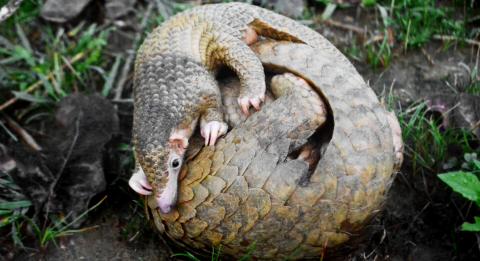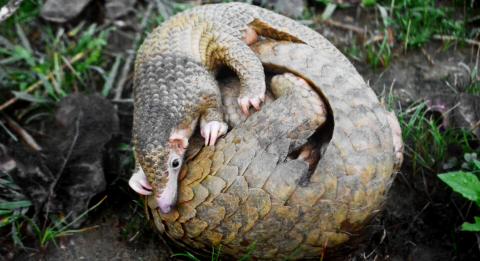Coming together to protect the critically endangered pangolin

Shy, slow-moving, and mainly nocturnal. They live in forests and grasslands, finding tree hollows or digging deep burrows to sleep and rest in. And when threatened, they curl up into a ball, their tough and thick scales acting as armour to protect their soft bellies.
Meet the pangolin: a unique, prehistoric mammal that has been around for 80 million years. Today, their species are under constant threat from poaching and trafficking, but with governments, conservation groups, and individuals coming together, they may have a shot at survival.
There are eight known species of pangolins spread across Asia and Africa. All are listed in the threatened tier of the Red List of the International Union for Conservation of Nature.
In Southeast Asia, two pangolin species consider the region their home: the Sunda pangolin (Manis javanica) and the Philippine pangolin (Manis culionensis).
Found in Brunei Darussalam, Cambodia, Indonesia, Lao PDR, Malaysia, Myanmar, Singapore, Thailand, and Viet Nam, the Sunda pangolin covers the most geographic range in the region. Pangolins found in the Philippines, particularly in Palawan Island, were previously thought to be Manis javanica, until recently recognised as a distinct species endemic only to the island.
Like their pangolin siblings across the world, the Sunda and Philippine pangolins have long snouts and tongues, which they use to eat ants and termites. They are mostly covered in protective scales made of keratin, the same substance that makes up hair, fingernails, and horn. These scales, unfortunately, are highly sought by poachers due to cultural beliefs that they possess medicinal properties.
Under threat
Both species found in the ASEAN Region are considered critically endangered. Due to their elusive nature, these species are hard to find, so there is scant knowledge about their behaviours and few reliable population estimates.
“Every part of the pangolin has some value in trade: its meat consumed and its scales used in traditional medicine,” said Nosrat Ravichandran, a protected area specialist of the ASEAN Centre for Biodiversity (ACB). “They are also threatened by habitat loss and fragmentation, which causes them to be easily accessible to poachers.”
The name “pangolin” is derived from the Malay word “penggulung,” which means “roller.” Against poachers and hunters, this defence mechanism has unfortunately become the species’ vulnerability, as they become easy to pick up once they roll up into balls.
Stories of these little pangolins published across the Internet, more often than not, are depressing stories that tell of their status as the world’s most trafficked mammals.
At least 895,000 pangolins from Asia and Africa have been trafficked internationally from the beginning of the millennium up to 2020. A study by international non-governmental organisation TRAFFIC found that an estimated equivalent of 7,634 Philippine pangolins was documented to have been confiscated from illegal trade and trafficking between 2000 to 2019.
Aside from these seizures, 2,870 frozen Sunda pangolins, weighing over 10 tonnes, were discovered in a vessel that ran aground in Tubbataha Reef in 2013.
Public awareness and citizen action
But growing appreciation about the plight of these wild animals, especially amid the COVID-19 pandemic, which has its roots in wildlife trafficking, can turn the tide on their plummeting population.
The ASEAN Member States have different wildlife laws that seek to protect endangered animals such as the pangolins and conserve their habitats. All ASEAN Member States are also signatories to the Convention on the International Trade in Endangered Wild Fauna and Flora, which ensures the regulation of the trade of wild animals and plants.
Beyond government policies and regulation, citizen science and involvement are crucial in ensuring that these pangolins would continue living their shy and quiet lives in the wild for the next 80 million years.
To raise public awareness on biodiversity conservation, the ACB has launched a three-year campaign called #WeAreASEANBiodiversity.
“[The] regional campaign, which promotes sharing of inspiring biodiversity stories, can also be instrumental in building stronger partnerships between public and private sector to participate in conservation actions,” said ACB Executive Director Dr. Theresa Mundita Lim.
Dr. Arvin Diesmos, director of ACB’s Biodiversity Information Management unit highlighted the campaign’s crucial role in popularising science, laws, instruments, and statuses of the species and their habitats for many different sectors, especially among the youth.
Diesmos also emphasised the need for the public to know their right sources of information about biodiversity and the natural environment.
“The work of researchers, scientists, conservation biologists, and citizen scientists is more important now than ever before, especially in generating the right kind of scientific information, both technical and popular,” he said.
Dr. Lim said the ACB has been working with different sectors to protect and care for these shy and elusive creatures. Initiatives such as the ASEAN Heritage Parks (AHP) Programme seek to support areas of high conservation importance that often host pangolins and other wildlife species.
“Keeping pangolins safe means not only protecting their populations in the wild but also the ecosystems that serve as their natural habitats. Integrated actions that include curbing poaching and wildlife trafficking, habitat protection, and improving the socio-economic conditions of the people living in and around pangolin range areas are encouraged,” said Dr. Lim.

